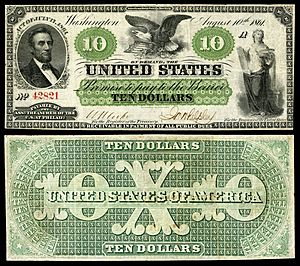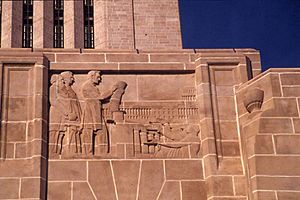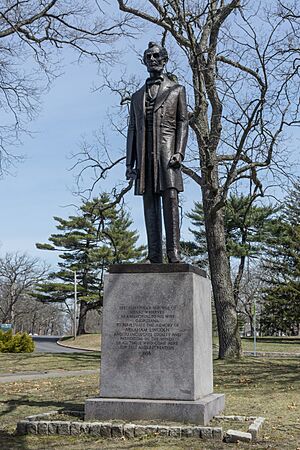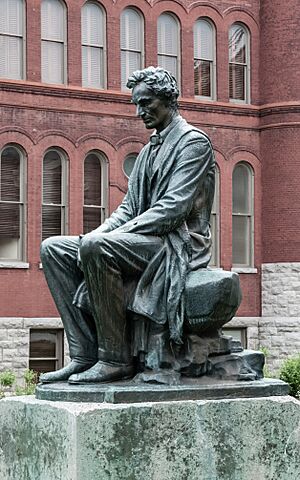Memorials to Abraham Lincoln facts for kids
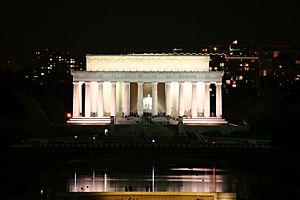
Abraham Lincoln was the 16th President of the United States. He served from 1861 to 1865. Many towns, cities, and counties are named after him. Along with George Washington, Lincoln is a famous symbol of American democracy and national pride.
Contents
How People See Lincoln Now
A person who studies how cultures remember things, Barry Schwartz, says that in the 1930s and 1940s, people thought of Abraham Lincoln as almost holy. He was a "moral symbol" that guided American life. During the Great Depression, Lincoln helped people understand their troubles. He made their suffering feel meaningful.
When Franklin D. Roosevelt was getting America ready for World War II, he used Lincoln's words. This helped explain the danger from Nazi Germany and Empire of Japan. Americans would ask, "What would Lincoln do?"
However, Schwartz also noticed that after World War II, Lincoln's importance as a symbol has faded. He thinks this shows a loss of faith in America's greatness. He believes that modern ideas like postmodernism and multiculturalism have changed how people view great figures.
Lincoln is still seen as one of the best presidents in history. But many presidents have become less famous in people's minds. Schwartz calls this the "acids of equality." As the culture of the United States became more diverse and equal, old symbols and traditions became less strong.
Lincoln's historic sites are still popular places to visit. But fewer people go there now. For example, in the late 1960s, 650,000 people visited the Lincoln Home National Historic Site each year. By 2000–2003, this number dropped to 393,000. Visits to Lincoln's New Salem also fell by half. This was likely because a new museum in Springfield became very popular. The Lincoln Memorial in Washington, D.C., had 4.3 million visitors in 1987. This number has also gone down since then. However, more people are now visiting Ford's Theatre in Washington, D.C.
Groups That Honor Lincoln
The oldest group in the United States that honors Lincoln is the Lincoln Association of Jersey City. It started in Jersey City, New Jersey, in 1865. This was soon after Lincoln was killed.
This group has a dinner every year on Lincoln's birthday, February 12. Many important people have spoken at these dinners. These include politicians, military heroes, teachers, and civil rights leaders. In 2015, the group celebrated its 150th anniversary. They placed a wreath at the entrance to Lincoln Park in Jersey City. The speaker at their annual dinner was Todd Brewster. He wrote a book called Lincoln's Gamble. It is about the hard work to create the Emancipation Proclamation.
Places That Remember Lincoln
Many places are named after or honor Abraham Lincoln. For example, the capital city of Nebraska, Lincoln, Nebraska, was named in 1867. The first public statue of Lincoln after his death was put up in front of the District of Columbia City Hall in 1868. This was three years after he was killed.
In 1876, on the day he died, a special memorial was opened. It was called the Freedmen's Memorial. People who had been freed from slavery paid for it to honor Lincoln. It is in Lincoln Park, Washington D.C. President Grant was there for the opening. Other important people like cabinet members, Supreme Court members, and Congress members also attended. Frederick Douglass gave the main speech.
The first national memorial to Abraham Lincoln was the historic Lincoln Highway. This was the first road for cars across the United States. It was opened in 1913. This was nine years before the Lincoln Memorial in Washington D.C. was opened in 1921.
Lincoln's name and picture are on many other things and places. These include the Lincoln Memorial in Washington, D.C., and his face on Mount Rushmore. Other places that honor the president are the Abraham Lincoln Birthplace National Historical Park in Hodgenville, Kentucky, and the Lincoln Boyhood National Memorial in Lincoln City, Indiana. Also, there is Lincoln's New Salem, Illinois, and the Lincoln Home in Springfield, Illinois.
The Lincoln Memorial at Louisville Waterfront Park has a very large statue of Lincoln sitting down. It is twice life-size. Around him are sculptures that show the history of slavery. Lincoln saw slave markets in Kentucky.
Ford's Theatre and Petersen House (where Lincoln died) are now museums. The Abraham Lincoln Presidential Library and Museum is in Springfield. The Lincoln Tomb in Oak Ridge Cemetery in Springfield, Illinois, holds his body. His wife Mary and three of their four sons are also buried there. Springfield's airport is named after him, the Abraham Lincoln Capital Airport.
There was also the "Great Moments with Mr. Lincoln" show at Disneyland. And the "Hall of Presidents" show at Walt Disney World. These were made because Walt Disney admired Lincoln since he was a child.
Lincoln Memorial University is in Harrogate, Tennessee. It is near the Cumberland Gap National Historical Park. It was started in 1897 to be a living memorial to President Lincoln. The Abraham Lincoln Library and Museum on campus has many items related to Lincoln.
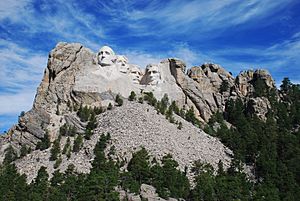
Protecting Lincoln's Tomb
On November 7, 1876, some people who made fake money tried to steal Lincoln's body. They wanted to hold it for money to free their leader, Benjamin Boyd. He was in prison for making fake money plates. The group got into the tomb. But they only partly moved the marble lid. A US Secret Service agent, who was secretly part of their group, told the police. Some of the criminals got away, but most went to prison for one year. For about ten years after that (1876–1887), Lincoln's tomb was moved around. This was to stop anyone else from trying to dig up his body.
Statue Attack
On August 16, 2017, a statue of Abraham Lincoln in a park in West Englewood, Chicago was spray-painted black. Later, it was covered in tar and set on fire.
Lincoln on Money and Stamps
Within a year of his death, Lincoln's picture started appearing on stamps around the world. He is on many United States postage stamps. Lincoln is the only U.S. President to be on a U.S. airmail stamp.
More than 50 countries around the world have put his picture on their stamps.
Lincoln was one of only five people to be shown on United States paper money while they were still alive. He has been on many different money amounts ($1, $5, $10, $20, $100, and $500). He has appeared on different types of money since the first U.S. Bank Note in 1861. Besides the modern United States five-dollar bill, the Lincoln cent coin also honors him. This coin was the first U.S. coin to regularly show a real person's image.
The artist Salvador Dalí used Lincoln's picture from the five-dollar bill. He did this to celebrate the U.S. Bicentennial. He created a painting called "Gala looking at the Mediterranean Sea which at a distance of 20 meters is transformed into the portrait of Abraham Lincoln (Homage to Rothko)". This painting was shown at The Guggenheim in New York in 1976.
Lincoln Around the World

The first statue of Lincoln outside the United States was put up in Edinburgh, Scotland, in 1893. It was made by George Edwin Bissell. It is part of a memorial to Scottish immigrants who joined the Union army during the Civil War. This is the only memorial to the war built outside the United States.
Another statue by George Grey Barnard was put up in Manchester, England, in 1919. It is now in Lincoln Square. This statue remembers how the American Civil War affected the cotton-making areas of Manchester and Lancashire.
A large statue of Lincoln standing by Saint Gaudens was shown near Westminster Abbey in London. This happened on July 28, 1920, in a big ceremony. The main speeches were given in Central Hall. In 1964, U.S. President Lyndon Johnson gave a Saint Gaudens statue to the people of Mexico. It is now in Mexico City's Parque Lincoln.
Lincoln's Birthday
Abraham Lincoln's birthday is February 12. It was never a national holiday on its own. But at one time, about 30 states celebrated it. In 1971, Presidents Day became a national holiday. It combined Lincoln's and Washington's birthdays. This replaced most states' celebrations of his birthday.
The Abraham Lincoln Association started in 1908. It was formed to celebrate 100 years since Lincoln's birth. In 2000, Congress created the Abraham Lincoln Bicentennial Commission. This group was to celebrate his 200th birthday in February 2009.
Sculptures in the United States
- A sculpture on the "Michigan Soldiers' and Sailors' Monument" in Detroit, Michigan, 1867.
- Abraham Lincoln, by Lot Flannery, in Washington, D.C. (1868).
- Abraham Lincoln, by Henry Kirke Brown, in Union Square, New York City, NY (1870).
- Abraham Lincoln, by Henry Kirke Brown, in Prospect Park, Brooklyn, NY (1869).
- Abraham Lincoln, by Vinnie Ream, in the United States Capitol rotunda, Washington, D.C. (1871).
- Lincoln Tomb, by Larkin Goldsmith Mead, in Springfield, Illinois (1874).
- Emancipation Memorial, by Thomas Ball, in Washington, D.C. (1876).
- Abraham Lincoln: The Man, also called Standing Lincoln, by Augustus Saint Gaudens, in Chicago, Illinois (1887).
- Abraham Lincoln, by Alfonso Pelzer, in Detroit, Michigan (1898, this copy around 1915).
- Abraham Lincoln Statue and Park, in Clermont, Iowa, 1902.
- Lincoln, The Emancipator, by Charles Henry Niehaus, at Buffalo History Museum, Buffalo, New York (1902). A copy is in Muskegon, Michigan.
- Abraham Lincoln: The Head of State also called Seated Lincoln, by Augustus Saint Gaudens, in Chicago, Illinois (1908).
- Abraham Lincoln, by Adolph Alexander Weinman, in Hodgenville, Kentucky (1909).
- Seated Lincoln, by Gutzon Borglum, in Newark, New Jersey (1911).
- Abraham Lincoln, by Adolph Alexander Weinman, at Kentucky State Capitol, Frankfort, Kentucky (1911).
- Standing Lincoln at the Nebraska State Capitol, Lincoln, Nebraska, by Daniel Chester French (1912).
- Abraham Lincoln at The Pennsylvania State Memorial, by J. Otto Schweizer, in Gettysburg, Pennsylvania (1913).
- Statue of Abraham Lincoln, by George Grey Barnard, in Cincinnati, Ohio (1917).
- Abraham Lincoln in the Lincoln Memorial, by Daniel Chester French (1914–22).
- Statue of Abraham Lincoln, at Civic Center, San Francisco, by Haig Patigian (1926).
- Lincoln the Lawyer, in Urbana, Illinois, by Lorado Taft (1927).
- Statue of Abraham Lincoln, at South Park Blocks, Portland, Oregon, by George Fite Waters (1928).
- Mount Rushmore, by Gutzon Borglum (1927-1941).
- Lincoln Monument (Dixon, Illinois), by Leonard Crunelle (1930).
- Lincoln Bank Tower, 3 panels: Pioneer Backwoodsman, Preservation of the Union and Emancipation Proclamation in Fort Wayne, Indiana (1930).
- Emancipation Proclamation, at Nebraska State Capitol, by Lee Lawrie, in Lincoln, Nebraska (1932).
- Abraham Lincoln: The Hoosier Youth, by Paul Manship, in Fort Wayne, Indiana (1932).
- Abraham Lincoln Walks at Midnight, by Fred Torrey (1933), cast by Bernard Wiepper, at West Virginia State Capitol (1974).
- Abraham Lincoln Statue, by Bryant Baker, at Delaware Park, Buffalo, New York (1935).
- Lincoln Trail State Memorial, by Nellie Verne Walker, near Lawrenceville, Illinois (1938).
- Abraham Lincoln Monument, by Samuel Cashwan, in Ypsilanti, Michigan (1938).
- Abraham Lincoln statue by Charles Keck in Hingham, Massachusetts (1939). Lincoln's family had lived in Hingham.
- Young Lincoln by Charles Keck, at Senn Park, Chicago (1945).
- The Chicago Lincoln, also called Beardless Lincoln, by Avard Fairbanks, in Chicago, Illinois (1956).
- Abraham Lincoln by Gilbert A. Franklin, at Roger Williams Park in Providence, Rhode Island (1958). This 12-foot bronze is the only monument to Abraham Lincoln in Rhode Island.
- Young Abe Lincoln, by David K. Rubins, in Indianapolis, Indiana (1962).
- Young Abraham Lincoln, also known as Abraham Lincoln on Horseback, "Abraham Lincoln Equestriam Monument," and Abraham Lincoln on the Prairie, by Anna Hyatt Huntington. Copies are in Northwood Institute, Midland, Michigan (1963); State University of New York, College of Environmental Science and Forestry, Syracuse, New York (1963); Salem State Park, Petersburg, Illinois (1963–64); and Lincoln City, Oregon (1965).
- Seated Lincoln, a 1968 copy of the 1930 James Earle Fraser bronze at Syracuse University, New York.
- Mr. Lincoln's Square, Clinton, Illinois.
- State of Lincoln "outside the old ironworks that powered the Confederate artillery," Richmond, Virginia.


